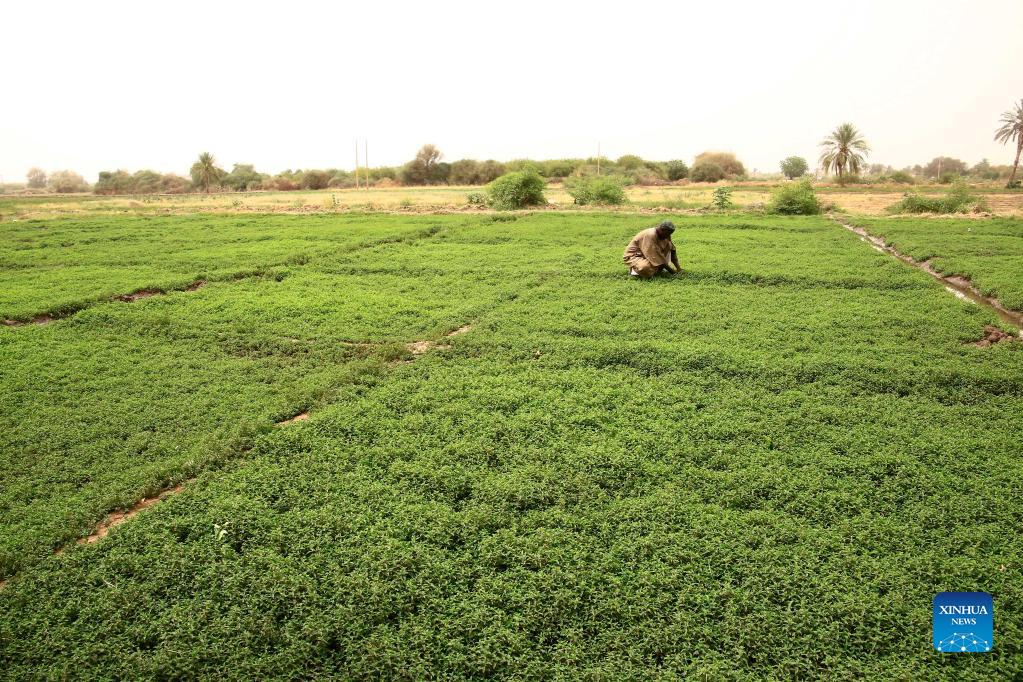
A farmer works in his farm in Khartoum, Sudan, May 22, 2022. Sudan faces a deteriorating food shortage or even a crisis in 2022 and the people suffering acute hunger may amount to some 18 million out of the country's total 45 million population, local experts have warned. (Photo by Mohamed Khidir/Xinhua)
KHARTOUM, May 22 (Xinhua) -- Sudan faces a deteriorating food shortage or even a crisis in 2022 and the people suffering acute hunger may amount to some 18 million out of the country's total 45 million population, local experts have warned.
The three main contributors to worsening food shortage in Sudan are the Russian-Ukrainian crisis, internal economic policies and weak agricultural production, according to Sudanese economic experts.
"It is known that Sudan gets more than 90 percent of its needs of wheat from Russia and Ukraine," Abdul-Khaliq Mahjoub, a Sudanese economic expert, told Xinhua.
"It is difficult to find alternative sources at present, and given the impact of the crisis, Sudan faces risks represented in its inability to purchase wheat at high prices," he added.
Currently, the price of wheat per tonne in Sudan amounts to more than 600 U.S. dollars, 180 percent higher than the same period last year.
Mohamed Al-Nayer, a lecturer of economics at Africa International University in the capital Khartoum, blamed the government policies for the risks of food insecurity in the country.
"Most of the international reports are trying to show the Russian-Ukrainian crisis is the cause of the global food crisis, but for Sudan, the government's irrational policies act as the main reason," Al-Nayer said in an interview with Xinhua.
"Owing to the lack of concern with farmers, failure to provide agricultural technologies and harvesting machinery, and failure to purchase wheat from farmers (at a reasonable price), the government is compelled to import wheat," he explained.
The production of grain, especially wheat, has decreased this year in Sudan because of the high costs, especially in oil products, fertilizers shortage and the epidemics, according to the annual Crop and Food Supply Assessment Mission (CFSAM) report.
During 2021-2022 agricultural season, the total grain production amounted to 5.1 million tonnes, 37 percent lower than the previous season of 8.1 million tonnes, said the report.
Also, the government's failure to purchase the wheat at an earlier set price may force farmers to smuggle their crop outside the country, said Al-Nayer.
In its latest report on the food situation in Sudan, the UN Office for Humanitarian Affairs warned that 14.3 million Sudanese people, representing about 30 percent of the country's population, would need food aid in 2022.
Sudan has been witnessing a continued rise in prices of bread made of wheat flour, as one loaf of bread now costs about 50 Sudanese pounds (0.11 U.S. dollars).
Sudan has been plagued by an economic crisis since the secession of South Sudan in 2011, which costs Sudan 75 percent of its oil revenues.
The crisis was exacerbated when the United States and international agencies suspended aid after Abdel Fattah Al-Burhan, the general commander of the Sudanese armed forces, declared a state of emergency on Oct. 25, 2021 and dissolved the Sovereign Council.
The United States has suspended 700 million dollars in economic aid to Sudan, while the World Bank failed to offer Sudan the 500 million dollars due in November 2021. The International Monetary Fund (IMF) also halted the 150 million dollars in special drawing rights for Sudan.
Sudan's debt relief process under the Heavily Indebted Poor Countries Initiative of the IMF has also been suspended. ■

Photo taken on May 22, 2022 shows a grain shop at a local market in Khartoum, Sudan. Sudan faces a deteriorating food shortage or even a crisis in 2022 and the people suffering acute hunger may amount to some 18 million out of the country's total 45 million population, local experts have warned. (Photo by Mohamed Khidir/Xinhua)



